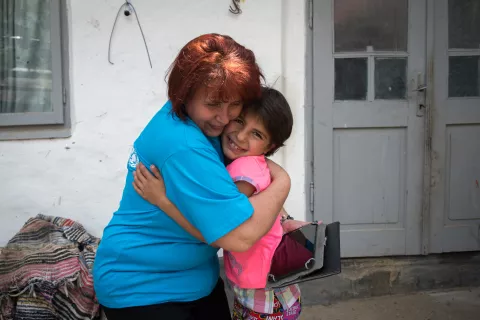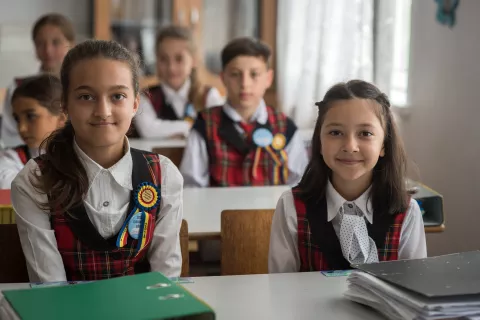What’s up with grade 8A?
In Romania, one in five children doesn’t complete eighth grade. And three in 10 don’t complete high-school or vocational schools. The transition to ninth grade brings an immense challenge, especially to vulnerable children. And dreams hang in the balance.

- Available in:
- English
- Română
“If you don’t finish high-school, you won’t get to live the dreams you had when you were little.” She doesn’t look her colleagues in the eye, but Ștefania tells them her mother’s words like they’re important. Lined up on chairs to her right, her colleagues listen respectfully. They all have dreams.
Nando wants to be an actor. Corina dreams to be an interpreter. Ștefania wants to become someone in music. As does Mara. Bianca first wanted to be a police woman, but now wants to be a psychologist, and help people with depression.
At closer inspection, almost half of the children in grade 8A at the Alecu Russo School want to study social sciences.
Maybe as a reaction to their humanities teachers, offers their class mistress, or maybe they’re dodging math, as jokes their history teacher.
A few months ago, though, they had a psychology teacher visiting from the Carpen High School in town. They played games, he spoke with them and asked a few questions. And something changed.
Surely, it wasn’t just one time. For grade 8A, such activities happen all the time, in the UNICEF Quality Inclusive Education Package, which also has a component supporting pupil’s transition to high school, called “Together for the Future.” Their school has been in the program for years.
Grade 8A, though, seems to have something extra. On the left side as you enter the classroom, three laptops are lined up on the desks.
They brought us the ideas they took from their training.
They like it best when teachers bring in slides or youtube videos to class. For instance, when they came from the UNICEF trainings, ”they brought us the ideas they took from there,” says Corina, who has one of the three laptops. ”We filled in some forms after we watched them, we put down our feelings, and what we understood.”
And they like it when the teachers ”- get involved in our education… and are not uptight, not just about the textbook.” ”- For instance, our history teacher… could really be an actor,” …”when he tests us, you first need to process his jokes,” says Nando, as the others giggle.
Nando also has a laptop. As does Ștefania. In grade 8A there are three visually impaired students. To them, seeing is listening to the screen reader.
And if you ask them about high school, they are, just like their colleagues, afraid of the same one thing.
Who’s afraid of high school?
”When we came here in fifth grade, it was all so simple. They were all colleagues from before, they knew each other, they welcomed us. There, all will come from different places, I don’t know if integration will be as smooth. And even from the teachers…” says Corina, the student with the best grades in the entire school.
If all went perfectly in high school, they’d have friends, good grades and would be involved. Involved how? ”You get to participate in the decisions that influence you, even if only with an opinion, you’re not cast aside.”
”It’s not fear, it’s constructive emotion,” thinks Florentin Botezatu, the history teacher. ”It’s like you moved house. We’re here to support them as much as we can,” continues Botezatu, who organises, next month, an orientation tour for his students in a high-school in town.
Nando also thinks of friends when he thinks of high school. ”You make them step by step, not in a day. I don’t know how long it took here, not long, but in the sixth grade we were already friends.”
”What matters most is they continue their studies, find the support they need to adapt there. This transition is the hardest for the vulnerable,” explains principal Elena Roșca. Challenging as it may be in urban areas, 20 per cent even less children enroll from rural communities.
It’s like you moved house. We’re here to support them as much as we can.
Alecu Russo, a mass education school, received with open arms and included children with disabilities. It flexed this muscle in the UNICEF program. Teachers team up with education, health and social protection specialists and parents so that all children, especially the most vulnerable, receive the support they need.
And students of grade 8A got to study not only their textbooks, but also, inclusion.
To Elena Roșca, the outcome is ”the school is not anonymous anymore, it makes its presence known. We’re here, and we’re here beautifully, many times. I am proud of our students.”
About The Quality Inclusive Education Package
UNICEF in Romania developed the Quality Inclusive Education Package, a solution that makes the best use of the existing local resources, improving them and creating stronger links between families, school and communities to ensure all children have access to Quality Inclusive Education (QIE).
Our programme aims to ensure that all children start school at the right age, stay in school and learn to their maximum potential, to be prepared for life and employment. Starting with 2018, the Quality Inclusive Education Package has a component addressing the transition of pupils to high schools, called "Together for the future".
QIE is designed for all students and schools, but it focuses on the most vulnerable children and most disadvantaged schools.
QIE brings together school counsellors, teachers, school management and local authorities to identify and support families with adolescent students at risk of dropping out to access comprehensive services, including by facilitating access to cash benefits and scholarships.




